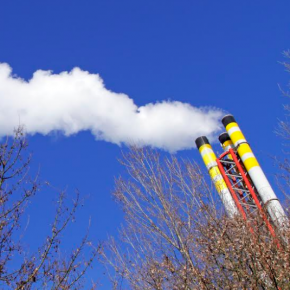
What is best for low grade plastics? – Axion talk
Keith Freegard, director of plastics recycler Axion Polymers, believes landfilling, as opposed to incineration, could be the best option for dealing with the UK’s waste plastic levels rising.
“CHINA’S crackdown on imports of contaminated recyclables is leading to an ever-increasing stockpile of waste plastics materials worldwide.
Tackling this problem waste stream will probably lead to increased incineration of waste to produce energy as the ‘best’ solution. An attractive option perhaps, but when the carbon produced by that process taken into account, is it really the best environmental solution?
Creating energy from waste also produces between 25% to 30% residual incinerator bottom ash (IBA), which still requires waste disposal or long-term storage.
Although generating heat and power from waste sounds appealing, it is inefficient when compared to burning gas in a modern generator system.
Burning natural gas also produces fewer emissions and there is nil solid ash waste to dispose of.
The carbon release from waste incineration needs to be considered and compared to the alternative methods of generating an equivalent amount of electrical power.
However, until world leaders are prepared to transform the taxation on fossil-based fuels in a way that truly reflects the high environmental cost of ‘free carbon release’, then this numeric analysis remains an esoteric academic study.
Perhaps we should start by calling end-of-life waste incineration technology ‘sky-fill’ to compare it with the alternative ‘land-fill’ disposal route for plastic-rich carbon mass?
Increasing incineration capacity also stifles innovation in alternative resource recovery technologies because investment is diverted away from developing new processes towards building huge plants for burning materials to inefficiently create power.
Having first raised the ‘landfill or incineration’ question more than 12 months ago, I still believe that the best environmental option may well be to store the waste plastics in a controlled landfill facility and then to ‘mine’ them back at a later date when new re-processing capacity becomes available.
Effectively acting as a long-term ‘carbon-sink’, these plastic materials could be extracted for recycling in the future if a new-process made this both technically and economically viable at that time.
Climate change concerns us all and efforts to control rising global temperatures have included a focus on the uncontrolled burning of fossil fuels in many parts of the world.
The huge shift in corporate and national energy-habits required to leave fossil fuels in the ground will only happen with a Carbon Tax placed on the generation of electrical power that is directly linked to the tonnes of CO2 released into the atmosphere per unit of power created.
If that happens, it might then be the time to return to that ‘mine’ of carefully stowed thousands of tonnes of good plastic and look again at the economics of turning it into new polymer.
With a huge carbon tax slapped on burning it, then the economics would probably work. So these plastics may not have to stay in the ground for too long.
Looking at the bigger picture, we should all be concerned about the wholesale damage to our planet caused by the completely uncontrolled burning of fossil fuels.
That’s what we’re doing when we’re burning plastic that’s encapsulated amongst the mixed MSW we put in our black bin bags.
Until we get a carbon tax that puts some seriously big pound notes on the cost of throwing carbon into the atmosphere, I don’t see there being any real change. After all, the Earth doesn’t have a bank account – it’s only us humans who operate under that monetary metric.
Visit Axion Polymers’ website – www.axiongroup.co.uk
Axion
Tenax Road
Trafford Park
Manchester
M17 1JT
Visit Supplier's page
Latest news

22nd November 2024
OPT Services Revolutionises Fibre Cable Capping with Eco-Friendly Innovation
UK-based OPT Services has unveiled SlimLine™ Capping, a groundbreaking fibre cable protection solution that promises to deliver significant environmental and installation advantages to the fibre optic industry.
Posted in Articles, Building Industry News, Building Products & Structures, Building Services, Facility Management & Building Services, Information Technology, Innovations & New Products, Sustainability & Energy Efficiency
22nd November 2024
CRL: The elegance of Paris balconies - a modern touch for any home
Paris balconies, with their timeless charm and practicality, are becoming something of an architectural staple in urban and rural environments, as CRL explains here…
Posted in Articles, Balustrades and Guardrails, Building Industry News, Building Products & Structures, Case Studies, Garden, Glass, Glass Projects, Restoration & Refurbishment, Retrofit & Renovation
21st November 2024
Altro distils style and performance at English Spirit
English Spirit Distillery has used an extensive package of Altro products front and back of house, in their new visitor centre café, shop and viewing area for the working distillery.
Posted in Articles, Bathrooms, Bedrooms & Washrooms, Building Industry News, Building Products & Structures, Building Systems, Case Studies, Floors, Interior Design & Construction, Interiors, Kitchens, Restoration & Refurbishment, Retrofit & Renovation, Timber Buildings and Timber Products, Walls
21st November 2024
Abloy UK creates bespoke locking solution for Secure Information Boxes
Abloy UK has supplied The Safety Letterbox Company Ltd with a bespoke Sentry CL811 Camlock for use in its Secure Information Boxes, assisting life safety and complying with new regulations and legislation for high rise buildings.
Posted in Access Control & Door Entry Systems, Architectural Ironmongery, Articles, Building Industry News, Building Products & Structures, Building Regulations & Accreditations, Building Services, Case Studies, Facility Management & Building Services, Health & Safety, Posts, Restoration & Refurbishment, Retrofit & Renovation, Security and Fire Protection
 Sign up:
Sign up: